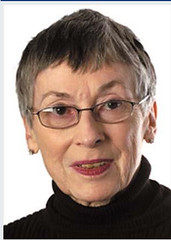Tiny things hit home in big ways
A Saturday in town could be just an ordinary day or, if you add it all up, an extraordinary one filled with pleasures that defy the putdown implied in the word "feel-good."
May 7, was that kind of Saturday for me.
First thing in the morning, a boy in a baseball uniform came to the door collecting for Little League. His father smiled from the sidewalk as I asked, "Are there girls on the team? Do they get to play?"
When he answered "yes" to both questions, I stuffed a dollar in his canister, thinking of the old days when the game was strictly for boys.
At the market, the bakery lady ran after a customer who had asked for sticky rolls. She had found one last package in her van and was happy to sell it to him. The egg lady eyed my torn jeans, which she could use for a rug she is weaving out of old ones -- as soon as I find time to get a new pair.
Cutting through the cemetery, I wondered why the caretaker stopped his mower. He wanted to make sure that nothing got thrown out at me from the blade.
On Howard Street, I looked over items at a yard sale and found out from the homeowner how to identify good cast iron. I may make a fortune yet.
Back on my street, two little boys took turns with a bike. One was barefoot -- a sure sign of warmer weather after a bone-chilling spring.
At evening services, Deacon Tom read a letter to mothers everywhere, thanking them for all the little things they do. And little things are what this day was all about, at least until I got home at 6 p.m. to watch the Kentucky Derby.
Jeremy Rose, riding Afleet Alex, the sentimental favorite to win, fought his way to what looked like the lead. As everyone now knows, he came in third in a breathtaking finish.
When I had Jeremy in senior homeroom, I missed him one morning when I took attendance. He came up to me later and said, "Mrs. Bechdel, you marked me absent this morning. I was there."
It's true. I didn't see him in the back of the room that day, but I couldn't miss him in his green-and-gold jockey silks riding a gorgeous horse in the country's biggest race.
For one Saturday in May, it was great to look past the irony and suspicion of our times and enjoy life's simple pleasures without apology.
May 7, was that kind of Saturday for me.
First thing in the morning, a boy in a baseball uniform came to the door collecting for Little League. His father smiled from the sidewalk as I asked, "Are there girls on the team? Do they get to play?"
When he answered "yes" to both questions, I stuffed a dollar in his canister, thinking of the old days when the game was strictly for boys.
At the market, the bakery lady ran after a customer who had asked for sticky rolls. She had found one last package in her van and was happy to sell it to him. The egg lady eyed my torn jeans, which she could use for a rug she is weaving out of old ones -- as soon as I find time to get a new pair.
Cutting through the cemetery, I wondered why the caretaker stopped his mower. He wanted to make sure that nothing got thrown out at me from the blade.
On Howard Street, I looked over items at a yard sale and found out from the homeowner how to identify good cast iron. I may make a fortune yet.
Back on my street, two little boys took turns with a bike. One was barefoot -- a sure sign of warmer weather after a bone-chilling spring.
At evening services, Deacon Tom read a letter to mothers everywhere, thanking them for all the little things they do. And little things are what this day was all about, at least until I got home at 6 p.m. to watch the Kentucky Derby.
Jeremy Rose, riding Afleet Alex, the sentimental favorite to win, fought his way to what looked like the lead. As everyone now knows, he came in third in a breathtaking finish.
When I had Jeremy in senior homeroom, I missed him one morning when I took attendance. He came up to me later and said, "Mrs. Bechdel, you marked me absent this morning. I was there."
It's true. I didn't see him in the back of the room that day, but I couldn't miss him in his green-and-gold jockey silks riding a gorgeous horse in the country's biggest race.
For one Saturday in May, it was great to look past the irony and suspicion of our times and enjoy life's simple pleasures without apology.

